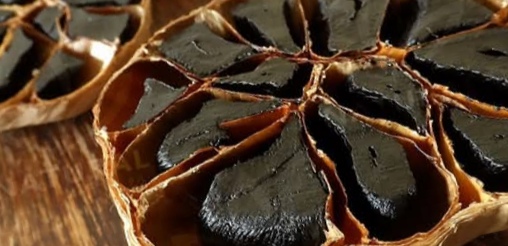Ingredients
Black garlic is a type of aged garlic that has been treated through a fermentation-like process under high heat and humidity for several weeks. This process not only changes its color to a deep black but also alters its texture and taste. The resulting garlic is soft, chewy, and has a sweet-savory taste, often described as balsamic-like or caramel-like. But beyond its unique flavor profile, black garlic is prized for its health benefits, which surpass those of regular garlic. Here’s a deeper look at what makes black garlic so special and beneficial.
Nutritional Benefits of Black Garlic
- Increased Antioxidant Levels: The aging process that black garlic undergoes increases its antioxidant properties significantly. These antioxidants help combat oxidative stress in the body, which is linked to numerous chronic diseases, including heart disease, Alzheimer’s, and certain cancers.
- Reduced Allicin but Increased S-Allyl-Cysteine (SAC): While black garlic contains less allicin, the compound responsible for fresh garlic’s strong odor and immediate health effects, it is rich in S-allyl-cysteine (SAC). SAC is a more stable compound that is easier for the body to absorb and has been linked to various health benefits, including cholesterol reduction and improved cardiovascular health.
- Anti-Inflammatory Properties: The compounds in black garlic help reduce inflammation in the body, which is a root cause of many chronic conditions, including type 2 diabetes, heart disease, and autoimmune diseases.
- Immune Boosting: Like fresh garlic, black garlic is also thought to enhance immune function but without the harsh raw garlic smell, making it more palatable and easier to include in your diet regularly.
Culinary Uses of Black Garlic
Black garlic can be used in a variety of culinary applications:
- Sauces and Marinades: Its sweet and umami flavor enhances sauces and marinades for meat, fish, and vegetables.
- Spreads and Dips: It can be mashed and spread on bread or crackers and is a delicious addition to dips.
- Salads: Chopped or sliced black garlic can be added to salads to provide a burst of flavor.
- Rice Dishes and Pastas: Incorporate black garlic into rice dishes or pasta sauces for a deep, complex flavor.
How to Make Black Garlic at Home
You can make black garlic at home using a rice cooker or a specifically designed black garlic fermenter:
- Prepare Garlic: Choose fresh, high-quality whole bulbs of garlic.
- Set Up Fermenter or Rice Cooker: Place the whole unpeeled bulbs in a rice cooker or a black garlic fermenter.
- Fermentation Process: Set the cooker to a warm setting (ideally around 140°F or 60°C) and let the garlic ferment for about three to four weeks. The garlic should be checked periodically to ensure it is transforming without drying out.
- Curing: Once the garlic turns black and soft, remove it and let it air out to cure for a few days before use.
Conclusion
Black garlic is a delightful and healthful addition to your culinary repertoire. Its unique taste and high antioxidant content make it an attractive ingredient for both health and culinary reasons. Whether purchased or homemade, incorporating black garlic into your diet can offer a new depth of flavor and a host of health benefits.
